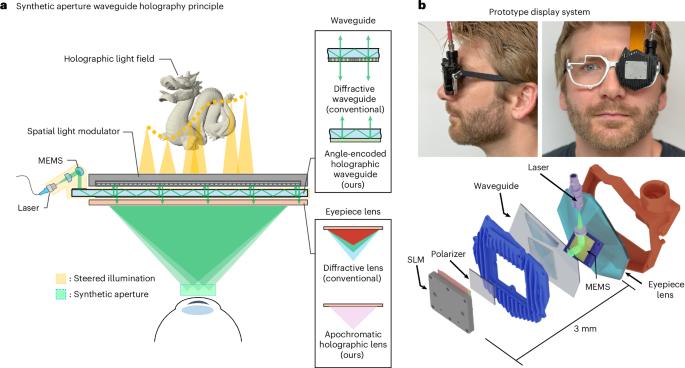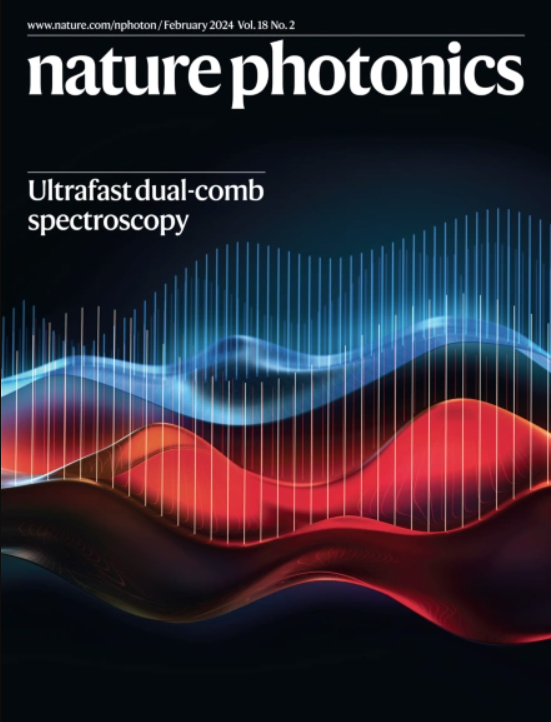小型混合现实显示器的合成孔径波导全息技术
IF 32.9
1区 物理与天体物理
Q1 OPTICS
引用次数: 0
摘要
混合现实(MR)显示系统可在通信、教育、培训和娱乐等各个领域实现革命性的用户体验。为了创造一种身临其境的可访问体验,MR显示器的显示引擎必须在大范围的瞳孔位置可观察到的宽视场上投射感知逼真的3D图像,也就是说,它必须支持一个大的可变空间。然而,目前的MR显示器在紧凑的设备外形因素中无法提供这些功能。在这里,我们提出了一种超薄磁共振显示设计,该设计使用波导全息和人工智能(AI)驱动的全息算法的独特组合来克服这些挑战。我们的显示系统的关键创新之一是一个紧凑的,定制设计的波导全息近眼显示,支持一个大的有效传输。这是与一个基于人工智能的算法框架联合设计的,该算法框架结合了隐式大波导模型、部分相干互强的有效波传播模型和计算机生成的全息框架。我们独特的波导全息系统和人工智能驱动的全息算法的共同设计代表了在紧凑的可穿戴设备中创造视觉舒适和感知逼真的3D MR体验的重要进步。本文章由计算机程序翻译,如有差异,请以英文原文为准。


Synthetic aperture waveguide holography for compact mixed-reality displays with large étendue
Mixed-reality (MR) display systems enable transformative user experiences across various domains, including communication, education, training and entertainment. To create an immersive and accessible experience, the display engine of the MR display must project perceptually realistic 3D images over a wide field of view observable from a large range of possible pupil positions, that is, it must support a large étendue. Current MR displays, however, fall short in delivering these capabilities in a compact device form factor. Here we present an ultra-thin MR display design that overcomes these challenges using a unique combination of waveguide holography and artificial intelligence (AI)-driven holography algorithms. One of the key innovations of our display system is a compact, custom-designed waveguide for holographic near-eye displays that supports a large effective étendue. This is co-designed with an AI-based algorithmic framework combining an implicit large-étendue waveguide model, an efficient wave propagation model for partially coherent mutual intensity and a computer-generated holography framework. Together, our unique co-design of a waveguide holography system and AI-driven holographic algorithms represents an important advancement in creating visually comfortable and perceptually realistic 3D MR experiences in a compact wearable device. An ultra-thin mixed-reality (MR) display design that is based on a unique combination of waveguide holography and artificial intelligence-driven holography algorithms is demonstrated, creating visually comfortable and perceptually realistic 3D VR experiences in a compact wearable device.
求助全文
通过发布文献求助,成功后即可免费获取论文全文。
去求助
来源期刊

Nature Photonics
物理-光学
CiteScore
54.20
自引率
1.70%
发文量
158
审稿时长
12 months
期刊介绍:
Nature Photonics is a monthly journal dedicated to the scientific study and application of light, known as Photonics. It publishes top-quality, peer-reviewed research across all areas of light generation, manipulation, and detection.
The journal encompasses research into the fundamental properties of light and its interactions with matter, as well as the latest developments in optoelectronic devices and emerging photonics applications. Topics covered include lasers, LEDs, imaging, detectors, optoelectronic devices, quantum optics, biophotonics, optical data storage, spectroscopy, fiber optics, solar energy, displays, terahertz technology, nonlinear optics, plasmonics, nanophotonics, and X-rays.
In addition to research papers and review articles summarizing scientific findings in optoelectronics, Nature Photonics also features News and Views pieces and research highlights. It uniquely includes articles on the business aspects of the industry, such as technology commercialization and market analysis, offering a comprehensive perspective on the field.
 求助内容:
求助内容: 应助结果提醒方式:
应助结果提醒方式:


